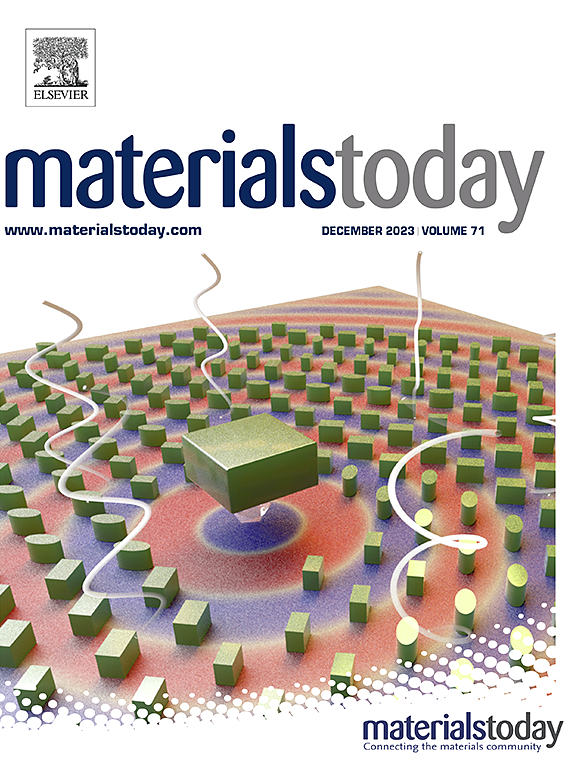用于生理温度下直接和嵌入式3D生物打印的双交联生物链接
IF 21.1
1区 材料科学
Q1 MATERIALS SCIENCE, MULTIDISCIPLINARY
引用次数: 0
摘要
生理温度下的生物打印对于在打印过程中和打印后保持细胞活力是理想的,特别是对于需要长时间制造的组织和器官规模结构。通常,生物墨水表现出温度粘度依赖性,并且在PT上表现出较差的印刷性,限制了结构复杂性和形状保真度。嵌入式生物打印提供了打印低粘度生物油墨的机会,然而,PT的考虑往往被忽视。在这项研究中,开发了一种双热响应和光交联的生物链接,包括明胶甲基丙烯酰(GelMA)和甲基纤维素(MC)或甲基丙烯酸甲基纤维素(MCMA)。这种生物墨水既可以作为直接挤压生物墨水,也可以作为嵌入式生物打印的支撑液。MC和明胶都表现出协同的热敏流变性能,这种特性被用于室温和PT下的生物打印,以创建具有可调性能的半互穿或相互连接的聚合物网络。生物墨水在温度为<时表现出溶胶-凝胶转变;27°C和>;33°C,分别代表GelMA和MC/MCMA的贡献,并改善了触变性和自愈行为。这些流变特性显着提高了在温度范围(18-37°C)下的打印性,并允许生物链接在PT上作为支撑浴。此外,在PT生物打印构建体中观察到更高的细胞存活率(> 90%)。生物打印构建体中的细胞反应取决于生物链接成分和细胞密度,低聚合物浓度和增加的细胞密度有利于脂肪来源干细胞的扩散和增殖。作为一个支撑槽,生物墨水可以通过嵌入式生物打印在PT上制造复杂的细胞负载结构。这使得各种细胞类型和可灌注通道的空间模式成为可能,支持浴作为基质提供长期支持和细胞储存库。生物墨水成功地扩展了PT直接和嵌入式生物打印的生物打印能力,并具有为组织工程应用制造大规模组织模型的良好潜力。本文章由计算机程序翻译,如有差异,请以英文原文为准。

Dual crosslinkable bioink for direct and embedded 3D bioprinting at physiological temperature
Bioprinting at physiological temperature (PT) is desirable to maintain cell viability during and after printing, especially for tissue and organ scale constructs requiring a long fabrication time. Typically, bioinks show a temperature viscosity dependence and exhibit poor printability at PT, limiting construct complexity and shape fidelity. Embedded bioprinting offers opportunities to print low viscosity bioinks, however, the consideration of PT is often neglected. In this study, a dual thermoresponsive and photocrosslinkable bioink was developed comprising gelatin methacryloyl (GelMA) and either methylcellulose (MC) or methylcellulose methacrylate (MCMA). This bioink serves as both a direct extrusion bioink and as a support bath for embedded bioprinting. Both MC and gelatin show synergistic thermosensitive rheological properties which was exploited to enable bioprinting at both room temperature and PT to create a semi-interpenetrating or interconnected polymer network with tuneable properties. The bioinks show sol–gel transitions at temperatures of < 27 °C and > 33 °C, representing the contribution from GelMA and MC/MCMA, respectively, and improved thixotropic, and self-healing behaviour at PT. These rheological properties significantly improve printability at a range of temperatures (18–37 °C) and allows the bioink to function as a support bath at PT. Moreover, higher cell viability (>90 %) post-bioprinting was observed in PT bioprinted constructs. The cell response in bioprinted constructs was dependent on bioink composition and cell density, with low polymer concentration and increased cell densities favouring the spreading and proliferation of adipose-derived stem cells. Acting as a support bath, the bioink enabled fabrication at PT of complex cell-laden structures through embedded bioprinting. This allowed spatial patterning of a variety of cell types and perfusable channels with the support bath acting as a matrix to provide long-term support and as a reservoir of cells. The bioinks successfully expand bioprinting capability at PT for both direct and embedded bioprinting and has promising potential to fabricate large-scale tissue models for tissue engineering applications.
求助全文
通过发布文献求助,成功后即可免费获取论文全文。
去求助
来源期刊

Materials Today
工程技术-材料科学:综合
CiteScore
36.30
自引率
1.20%
发文量
237
审稿时长
23 days
期刊介绍:
Materials Today is the leading journal in the Materials Today family, focusing on the latest and most impactful work in the materials science community. With a reputation for excellence in news and reviews, the journal has now expanded its coverage to include original research and aims to be at the forefront of the field.
We welcome comprehensive articles, short communications, and review articles from established leaders in the rapidly evolving fields of materials science and related disciplines. We strive to provide authors with rigorous peer review, fast publication, and maximum exposure for their work. While we only accept the most significant manuscripts, our speedy evaluation process ensures that there are no unnecessary publication delays.
 求助内容:
求助内容: 应助结果提醒方式:
应助结果提醒方式:


